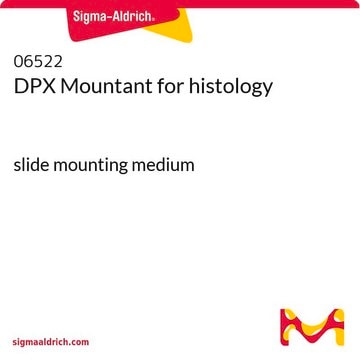If this product has an expiration or retest date, it will be shown on the Certificate of Analysis (COA, CofA). If there is no retest or expiration date listed on the product's COA, we do not have suitable stability data to determine a shelf life. For these products, the only date on the COA will be the release date; a retest, expiration, or use-by-date will not be displayed.
For all products, we recommend handling per defined conditions as printed in our product literature and website product descriptions. We recommend that products should be routinely inspected by customers to ensure they perform as expected.
For products without retest or expiration dates, our standard warranty of 1 year from the date of shipment is applicable.
For more information, please refer to the Product Dating Information document: https://www.sigmaaldrich.com/deepweb/assets/sigmaaldrich/marketing/global/documents/449/386/product-dating-information-mk.pdf
247642
Xylenes
ACS reagent, ≥98.5% xylenes + ethylbenzene basis
Synonym(s):
Xylene mixture of isomers
About This Item
Recommended Products
grade
ACS reagent
Quality Level
vapor density
3.7 (vs air)
vapor pressure
18 mmHg ( 37.7 °C)
Assay
≥98.5% xylenes + ethylbenzene basis
form
liquid
composition
C6H5CH2CH3, ≤25%
expl. lim.
7 %
impurities
H2SO4, passes test
≤0.003% S compounds
≤0.05% water
evapn. residue
≤0.002%
color
APHA: ≤10
refractive index
n20/D 1.497 (lit.)
bp
137-140 °C (lit.)
mp
-34 °C
density
0.86 g/mL at 25 °C (lit.)
SMILES string
Cc1ccc(C)cc1.Cc2cccc(C)c2.Cc3ccccc3C
InChI
1S/3C8H10/c1-7-3-5-8(2)6-4-7;1-7-4-3-5-8(2)6-7;1-7-5-3-4-6-8(7)2/h3*3-6H,1-2H3
InChI key
MVZVDAGWAAZJPE-UHFFFAOYSA-N
Looking for similar products? Visit Product Comparison Guide
General description
Application
- In the tetraphosphine/palladium-catalyzed Suzuki cross-coupling with sterically hindered aryl halides and arylboronic acids to synthesize tri-ortho-substituted biaryl adducts.
- For the N-alkylation of amines or ammonia with alcohols to synthesize N-alkyl amines.
- To synthesize aromatic polyimides by reacting unsymmetric phosphinated diamines and dianhydrides via solution polymerization.
Packaging
Signal Word
Danger
Hazard Statements
Precautionary Statements
Hazard Classifications
Acute Tox. 4 Dermal - Acute Tox. 4 Inhalation - Aquatic Chronic 3 - Asp. Tox. 1 - Eye Irrit. 2 - Flam. Liq. 3 - Skin Irrit. 2 - STOT RE 2 - STOT RE 2 Inhalation - STOT SE 3
Target Organs
Central nervous system,Liver,Kidney, hearing organs, Respiratory system
Storage Class Code
3 - Flammable liquids
WGK
WGK 2
Flash Point(F)
77.0 °F - closed cup
Flash Point(C)
25 °C - closed cup
Choose from one of the most recent versions:
Already Own This Product?
Find documentation for the products that you have recently purchased in the Document Library.
Customers Also Viewed
-
How can I determine the shelf life / expiration / retest date of this product?
1 answer-
Helpful?
-
-
How is shipping temperature determined? And how is it related to the product storage temperature?
1 answer-
Products may be shipped at a different temperature than the recommended long-term storage temperature. If the product quality is sensitive to short-term exposure to conditions other than the recommended long-term storage, it will be shipped on wet or dry-ice. If the product quality is NOT affected by short-term exposure to conditions other than the recommended long-term storage, it will be shipped at ambient temperature. As shipping routes are configured for minimum transit times, shipping at ambient temperature helps control shipping costs for our customers. For more information, please refer to the Storage and Transport Conditions document: https://www.sigmaaldrich.com/deepweb/assets/sigmaaldrich/marketing/global/documents/316/622/storage-transport-conditions-mk.pdf
Helpful?
-
-
What are the dissimilarities between Xylenes ACS (247642) and Xylenes histological grade (534056)?
1 answer-
The term "histological grade" does not have a precise definition; it simply indicates that the intended use for the product is in histology. For a histological grade product, the company selling the product sets the product specifications. In the case of xylene, there is no direct testing performed to ensure the product provides suitable performance in a wide range of histological procedures.
On the other hand, if a product is sold to ACS specifications, it means that any company selling an ACS grade of chemical must meet the specifications set forth by the American Chemical Society (ACS). Therefore, it should not make a difference as to which company an ACS grade product is sourced from.
It's possible that a histological grade of xylene may not be suitable for some applications, although it is likely suitable for many applications. However, there is an expectation that an ACS grade xylene should be suitable for use in histological applications, even though ACS does not include a suitability test for use in histology.
Helpful?
-
Active Filters
Our team of scientists has experience in all areas of research including Life Science, Material Science, Chemical Synthesis, Chromatography, Analytical and many others.
Contact Technical Service







